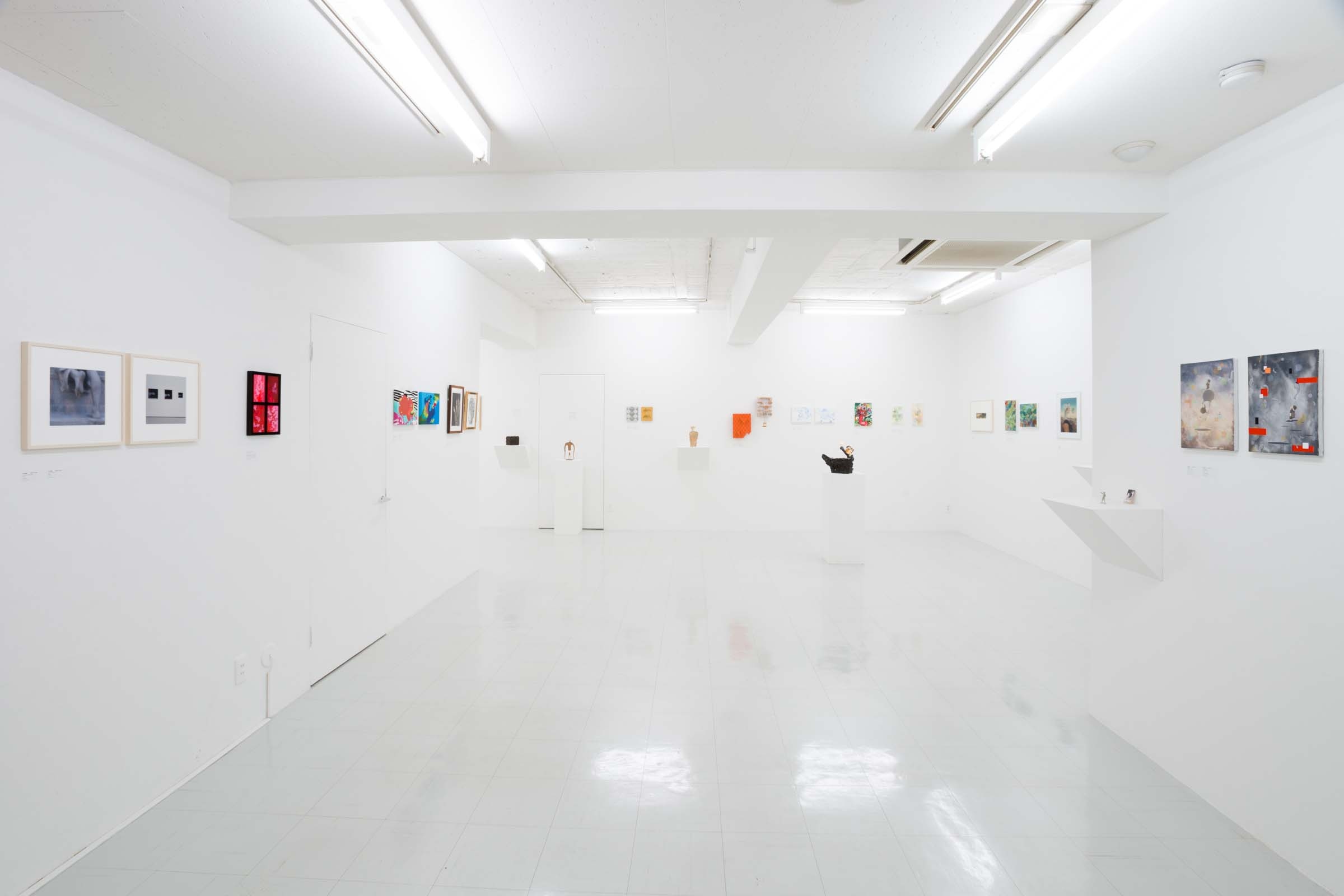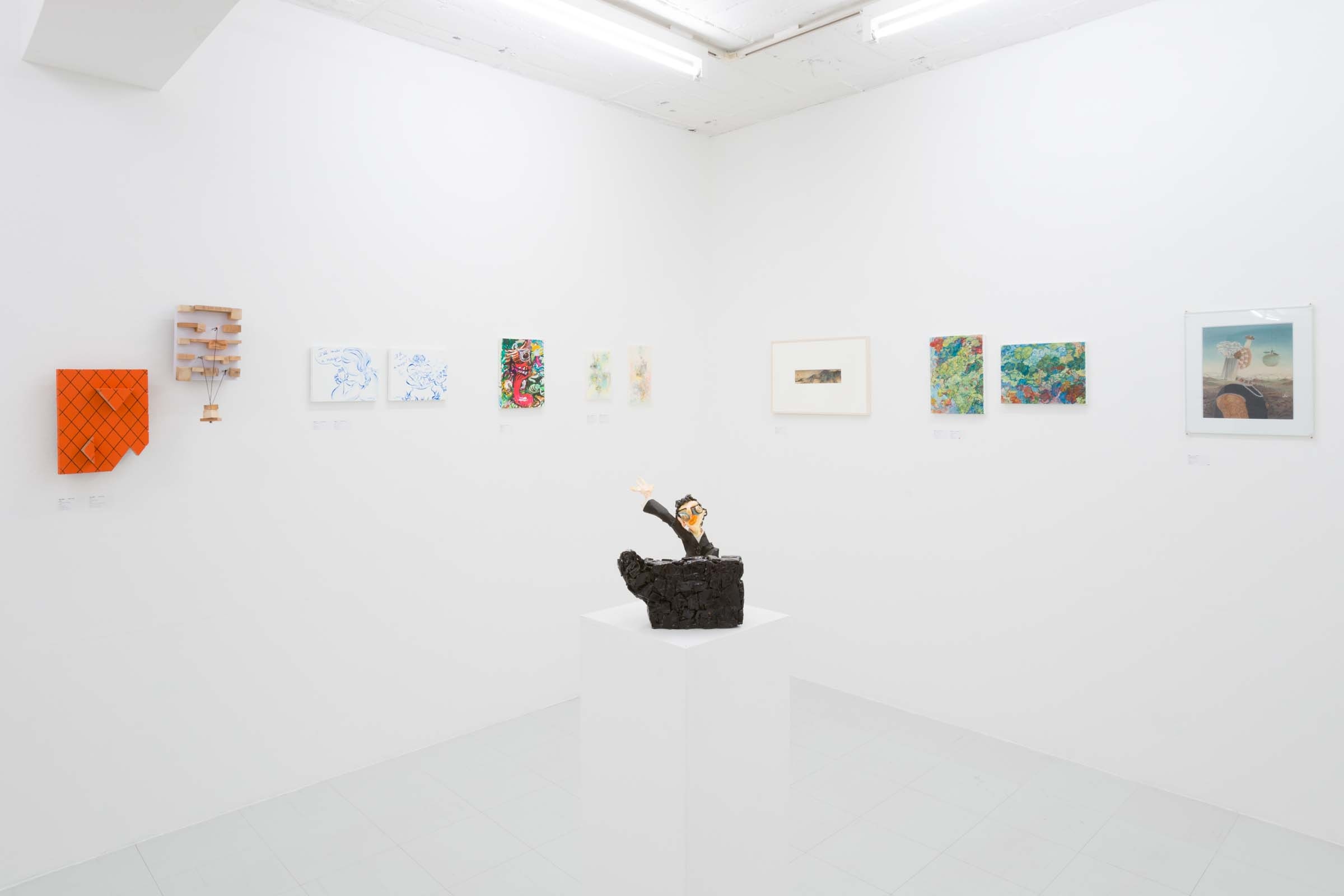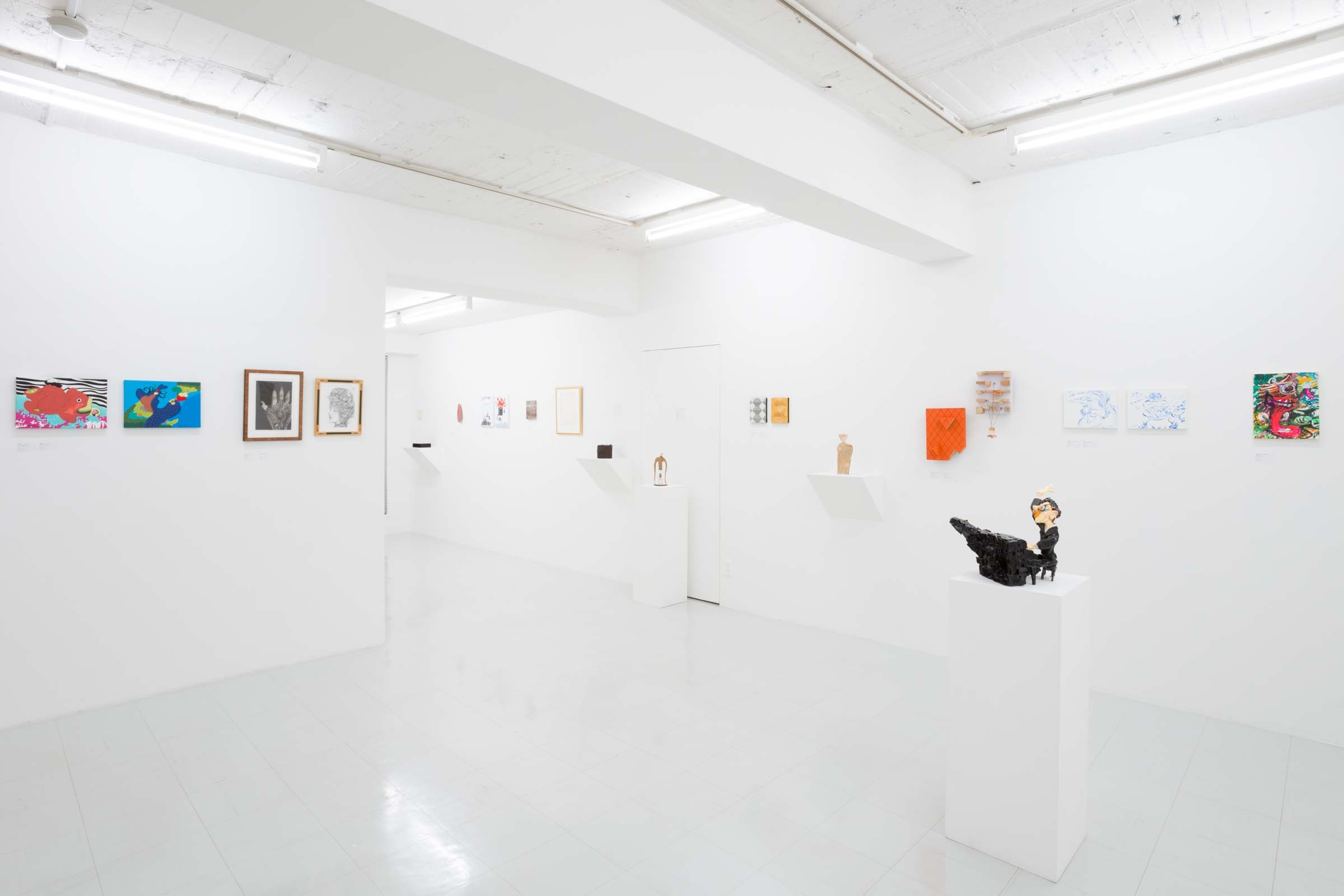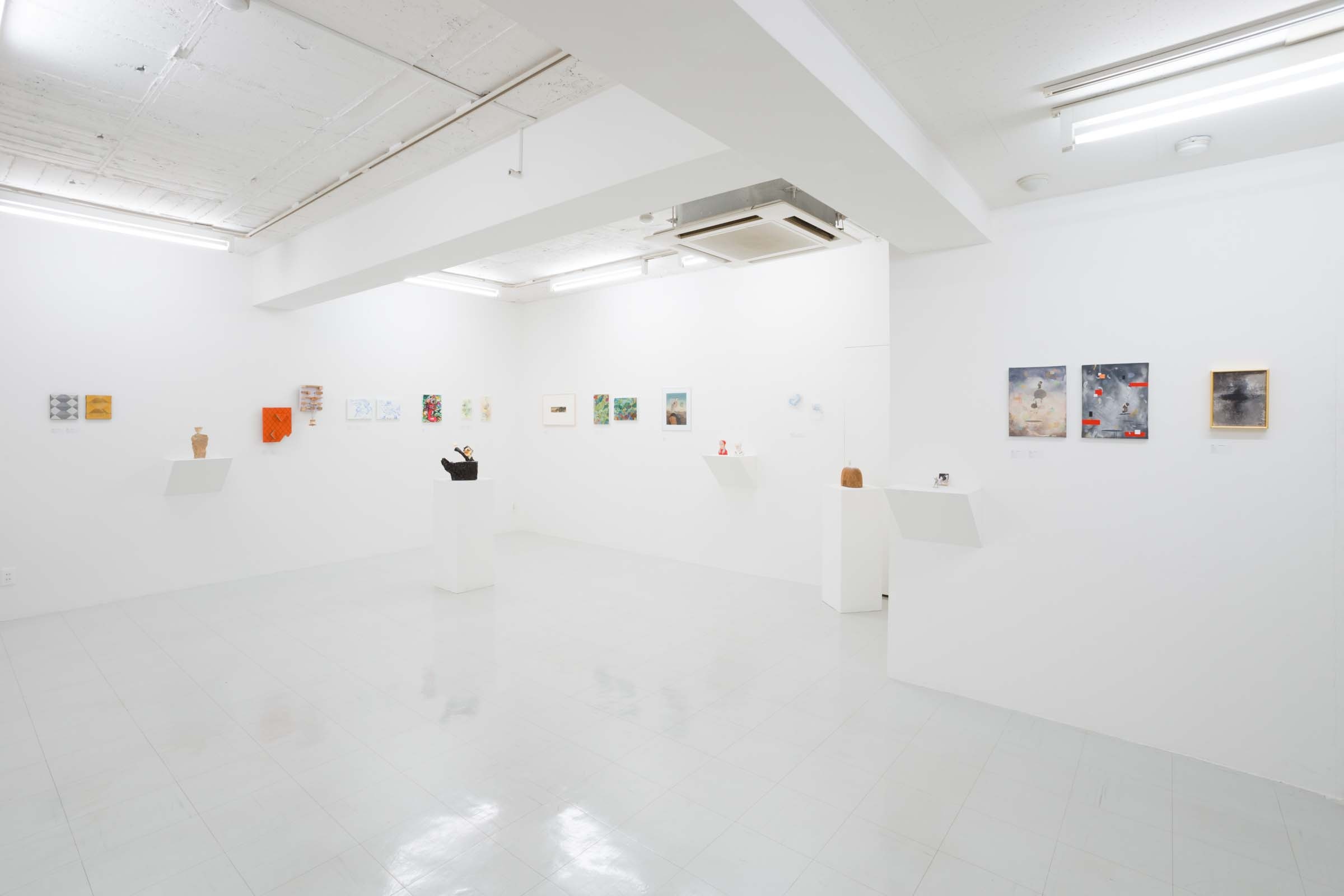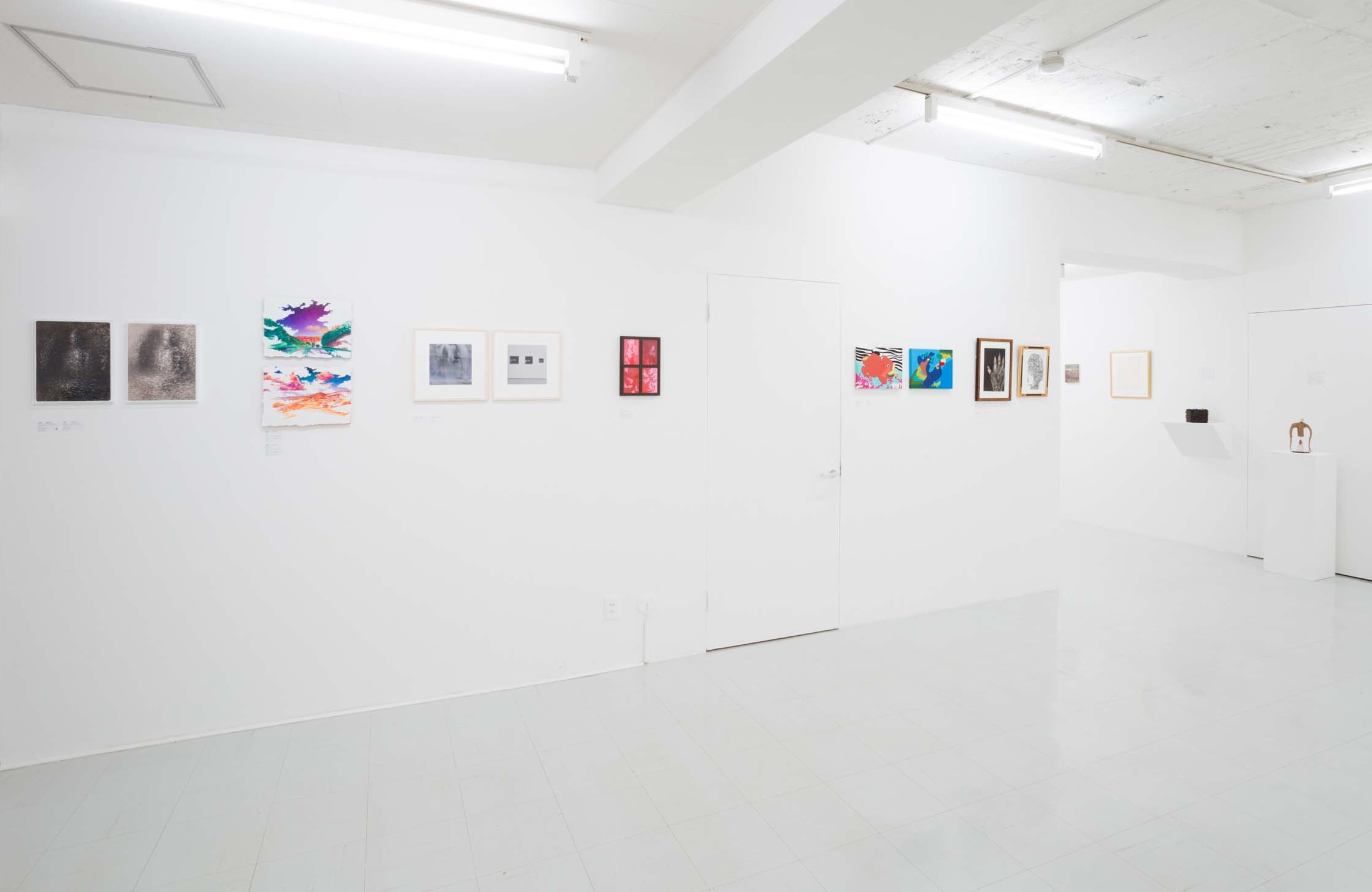Saya Irie
Born in 1983 in Okayama, Irie completed Hiroshima City University’s pre-doctoral art studies course in 2009, and is currently based in Hiroshima. She shows her work at solo exhibitions, specially curated exhibitions, and art festivals both in Japan and abroad, in addition to devoting herself to creating works during artist residencies in recent years. Irie has developed a unique technique that consists of rubbing out two-dimensional images with an eraser, and then using the eraser dust to recreate the same image in the form of a three-dimensional sculpture. By defamiliarizing existing images — through works that transform images of Kannon the Goddess of Mercy as depicted in Japanese hanging scrolls into three-dimensional forms, or reconfigure everyday objects and conversations into new mythologies — Irie prompts us to reconsider the relationship between representation and materiality in the contemporary world. Laced with humor, these works persistently question the nature of memory and faith within visual culture.
Learn MoreYuki-Katsura
Yuki Katsura (1913-1991) began creating collages from paper and cork in the pre-war period, and became a prolific artist who employed a variety of techniques and styles to draw various modes of paintings from abstraction, satires and caricatures. Before World War II, Katsura was a frequent participant of the Avant-Garde Western Painting Research Institute, which was established by painters such as Togo Seiji. Katsura was heavily involved in the genesis of the Japanese avant-garde movement, and was a founding member of the avant-garde Kyushitsukai group within Nikaten. Yuki Katsura provides us the key to understand the continuity of Japanese art before and after the war.
Learn MoreShowichi Kaneda
Showichi Kaneda was born in Kyoto in 1970. Since completing his postgraduate studies in painting at the Kyoto City University of Arts in 1995, he has been based in Kyoto, where he continues to live and work. Kaneda has also been teaching in the department of painting at his alma mater since 2009. Kaneda’s paintings and sculptures, the surfaces of which demonstrate an impressive use of rich vibrant colors, both use fiber-reinforced plastic and resin as supports. They make use of a variety of different materials in skillful combinations, such as oil paint, varnish, acrylic lacquer, automotive paint, decal and surfacer. Human’s Own, a striking series of sculptures based on motifs found on F1 “shark fin” engine covers, was originally inspired by thinking about the animal-like properties of human beings. These works express something of the essential human desire for profit and the relentless pursuit of speed. In addition to being a symbol of speed, the form of the F1 machine in Human’s Own is a metaphor for the shark, an animal that dies once it stops moving – an apt representation of the reality of our daily lives.
Learn MoreSusumu Koshimizu
Susumu Koshimizu was born in Uwajima in Ehime Prefecture in 1944. He enrolled in the Department of Sculpture of Tama Art University in 1966 and left school due to student protest in 1971. Koshimizu became a prominent artist in the Mono-ha movement from the 1960s, creating minimal sculptures and installation pieces from basic materials such as iron, wood and paper. He was a faculty of the Department of Sculpture at Kyoto City University of Arts from 1994 to 2010, and currently serves as a president of Takarazuka University. He is now based in Kyoto, Japan. Koshimizu participated in various international art exhibitions including Tokyo Biennale: Man and Matter, Venice Biennale and São Paulo Biennale. He is a recipient of numerous awards in Japan including the prize at 3rd Contemporary Sculpture Exhibition held at Suma Palace Garden, Kobe (1972); Prize for Excellence, 11th Teijiro Nakahara Award (1980); 10th Denchu Hirakushi Prize (1981); 38th Minister of Education’s Art Encouragement Prize for Freshman (1988); 2nd Kyoto Culture Prize (1989); Prize for Merit, Kyoto Prefectural Cultural Award (1999); 2nd Enku Garden Award (2003); Medal with Purple Ribbon (2004).
Learn MoreKishio Suga
Kishio Suga was born in 1944, Iwate prefecture, Japan. Suga graduated from the Painting Department of Tama Art University in 1968. From the late 1960s onwards, he has been active as one of the central figures of Mono-ha, a sculptural and installation based art movement that emerged in the late 1960s. Through his practice of assembling natural, industrial or found materials into a room size installation piece, he intends to examine the relation between objects, space, and human perception in tandem to the surrounding environment. Suga’s solo exhibitions have been organized by numerous museums in Japan including Kishio Suga Hiroshima City Museum of Contemporary Art, 1997; Stance, Yokohama City Museum, 1999; Uncertain Void: Installation by Kishio Suga, Iwate Museum of Art, 2005. His most recent solo show Situated Latency was held at the Contemporary Art Museum, Tokyo in 2015.
Learn MoreIsao Sugiyama
杉山功は1977年に東京造形大学彫刻科を卒業後、同大学研究室へ進学。1983年、卒業と同時にイタリアへと渡り、カラーラ美術アカデミーに入学します。卒業後はイタリアに留まり、ミラノ、カラーラを拠点に制作活動を行ってきました。これまで主にヨーロッパで個展を開催し、世界各地のグループ展やアートフェアで作品を発表しています。
杉山の彫刻は大理石と木から成ります。未加工の大理石を自然に見立て、そこに家のフォルムを配置することで、文明の存在をほのめかすのです。ゆっくりと風化していく石と、早々と朽ちて消える木の対比によって、自然の時間と文明の時間の異なるリズムが喚起されます。このような光景を俯瞰する作家あるいは我々の視点は、世界の全体を捉えようとする宗教的なビジョンとも言えるのです。
Yoshio Sekine
Yoshio Sekine was born in Wakayama, Japan. Sekine met the influential painter Jiro Yoshihara (1905-1972) through the Jiyu Bijutsu Kyoukai (Free Artists' Association) and was involved in the founding of the avant-garde Gutai group in 1954. In 1955, Sekine participated in The 7th Yomiuri Independent Exhibition. In 1958, his work was selected for an exhibition curated by Michel Tapié (1909-1987), The International Art of a New Era: Informel and Gutai, which launched at the Takashimaya Department Store in Osaka and then travelled to Tokyo, Kyoto, Hiroshima, and Nagasaki. Sekine left Gutai and moved to Tokyo in 1959. At The 15th Yomiuri Independent Exhibition in 1963, he presented a painting of an abacus for the first time. From this point, Sekine went on to build his oeuvre around recurring motifs such as abacuses, gates, rail wagons and Mt. Fuji. His other notable exhibitions include Trends in Contemporary Art: Paintings and Sculptures (the National Museum of Modern Art, Kyoto, 1964), The 2nd Nagaoka Contemporary Art Museum Award Exhibition (Nagaoka-shi, Niigata, 1965) and The 1960’s: A Decade of Change in Contemporary Japanese Art (the National Museum of Modern Art, Tokyo, 1981, later travelling to the National Museum of Modern Art, Kyoto). Sekine also received the prestigious Mainichi Art Award in 1952.
The abacus was perhaps the most prominent subject in Sekine's artistic career. He produced many works iterating this motif in a diverse range of colour schemes and compositions until his later years. Abacus beads can be moved and rearranged, each configuration signifying a number. Because of this reconfigurability and semiotic function, abacus beads make an intriguing motif for generating geometric compositions. In some of his works, the bead configuration indicates the date the work was completed. Through such play on a numerical sign system, Sekine's depictions of abacuses seem to turn to abstraction. Simultaneously, these works could also be seen as representational images that bring out the abstract qualities inherent to the abacus itself, achieving a new kind of 'realism' that transcends traditional illusionism.
Miki Taira
Miki Taira was born in 1984. After majoring in calligraphy at Tokyo Gakugei University, she began making sculptures incorporating calligraphy that are based on old Japanese folktales. Since winning the silver prize at Geisai #10 in 2006, Taira has been exhibiting her works at group shows and art fairs both in Japan and abroad. Taira’s works are inspired by oral traditions and folklore that originate in Japan’s rural countryside. She stitches together sheets of hemp cloth dyed with barley tea to form the characters in these stories, and then transcribes the folktale in question onto the surface of her sculptures in dense Japanese writing. While the textures of the cloth and brushstrokes impart an antique look to her works, there is also something faintly ridiculous about their abstract form that imbues them with a special humor.
Learn MoreMitsukuni Takimoto
Mitsukuni Takimoto was born in Fukuoka in 1952. He moved to Italy in 1977 to apprentice to Tomonori Toyofuku, who was active in Milan at the time. Since then, Takimoto has consistently pursued a wood sculpture practice while remaining faithful to traditional techniques. Takimoto also works as an expert in the restoration of Buddhist sculptures. Under the influence of Toyofuku, Takimoto worked on abstract sculptural reliefs throughout the 1980s. In the ‘90s he shifted his style toward a more representational one. However, while these works can be called representational, he chooses only subjects like waterfalls and rivers, clouds and smoke: figures that remain in the viewer’s memory like an afterimage. The chisel marks left on the surface of these fluid shapes are simultaneously traces of the act of making, and a symbolic representation of the conscious effort to grasp indeterminate images.
Learn MoreChiharu Nishizawa
Born 1970, Nagano Prefecture, Japan. Following his graduation with a major in Painting from the Fine Arts Department of Tokyo Zokei University, Nishizawa continued to work in the medium of printing, but moved to painting as he felt it was quicker at giving form to his thoughts. Having had a solo exhibition at Tokyo Opera City Gallery in 2003, won an award at VOCA in 2004, his work became critically acclaimed for its combined expression of unease towards society with its dark humor. In 2005 he held a solo exhibition at Tokyo Gallery, and continued to garner attention on the international stage with solo exhibitions in Hong Kong and Seoul. His work is known for its detailed, model-like depiction of crowds of people wearing suits or aprons against flat, unreal backgrounds. With his collaboration at Steinway Japan and a museum exhibition being held in Germany, he is continuing to make exciting developments in his work.
Learn MoreTakeshi Hayashi
Takeshi Hayashi was born in 1956 in Gifu Prefecture. After completing his graduate studies at the Tokyo University of the Arts, he stayed in Paris as a Ministry of Education, Culture, Sports, Science, and Technology (MEXT) overseas research fellow from 1998 to 1999. In 2024, he retired as a professor in the Department of Sculpture at the Tokyo University of the Arts. In 2012, he won the Enku Award at the 6th Enku Grand Award Exhibition for Daichito Kyomei – Sozono Genfukei (Earth and Resonance – the Root of Creation). Hayashi's artistic activity involves taking stones of varying sizes and shapes, and arranging them so as to explore the relationship between the stones, as well as the relationship between the stones and the space that surrounds them.
Learn MoreHiroyuki Matsuura
Hiroyuki Matsuura was born in Tokyo in 1964. It was SUPER ACRYLIC SKIN, an exhibition of Matsuura’s works at Tokyo Gallery in 2005, that marked his transition from designer to artist. Matsuura has gone onto lead an active career both in Japan and overseas, and broadened his repertoire to include the media of painting, sculpture, and print. In 2017, Uki-uki (2012), a 4-metre high work by the artist, was exhibited at Cool Japan: World Fascination in Focus, an exhibition hosted by Museum Volkenkunde in Leiden and Tropenmuseum in Amsterdam, and served as the main image used to advertise the exhibition. World Fascination in Focus subsequently travelled to Museum aan de Stroom in Antwerp, where it was well received.
Learn MoreShigeki Yoshida
Shigeki Yoshida was born in Ibaraki, Japan in 1963. He studied painting at Wako University in Tokyo. After graduation, Yoshida pursued his early career as a painter and had several solo and group shows in Japan, Korea and Thailand. In 1997, Yoshida was awarded a fellowship by the Japanese government and came to New York. Yoshida enrolled in the Hunter College MFA program where he studied photography with the late Prof. Mark Feldstein and Prof. Roy DeCarava. Yoshida also studied with Prof. Katharina Siverding at UDK in Berlin as an exchange student. Yoshida earned his MFA in 2005, and now lives and works in Brooklyn.
Learn MoreWang Shuye
Wang Shuye was born in China’s Heilongjiang province in 1963, and graduated from Beijing’s Central Academy of Craft Art (now renamed the Academy of Arts & Design of Tsinghua University) in 1989. That same year, his graduation work won the Gold National Award for Excellence, the highest honor awarded by the Ministry for Trade, Education and Industry. In 1990, Wang came to Japan and spent the next ten years devoting himself exclusively to the spiritual pursuit of art, exhibiting no work until his 2001 solo show in Kamakura. Since then he has been showing his paintings mainly in Tokyo and Kamakura, in addition to holding a retrospective exhibition at the Ikeda Museum of 20th Century Art in 2009 entitled The Affirmative Vision – The World of Wang Shuye. Wang took a leading role in organizing Neo-Moroism exhibition held at Tokyo Gallery + BTAP (Beijing) in 2013 by contribuiting a theoritical essay for the catalogue. Today, Wang continues to live and work in Kamakura, producing paintings that are informed by subtle yet tenacious executation and persistent spirit of inquiry.
Wang’s paintings, often covered by a mass of countless brushstrokes, use this layered technique to depict profound scenes of tranquil beauty. These visual spaces represent a world that exists prior to becoming a subject of our awareness. Standing in front of these large canvases, the viewer is freed from the constraints of the present moment and discovers the existence of another, more mercurial space and time. Although he used to work mainly with Chinese ink and pencil, Wang began using oil paint in 2007 in order to explore new directions in his artistic practice. By giving up his reliance on outlines and contours, Wang has enabled his vision to draw ever closer to his chosen subjects – so much so that he seems to approach the very essence of their materiality.
